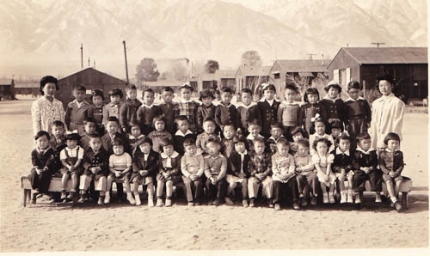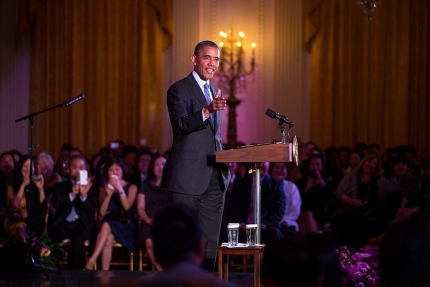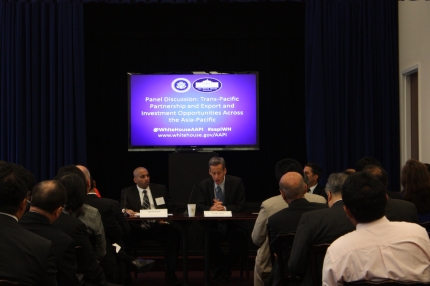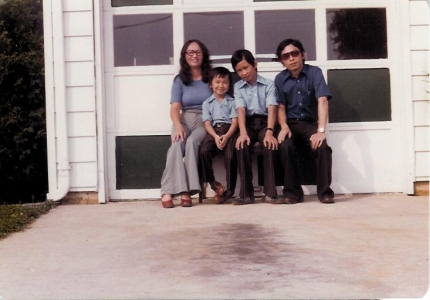Initiative on Asian Americans and Pacific Islanders Blog
Ansel Adams and My Dad: No Picture Taken
Posted by on June 12, 2013 at 9:38 AM EDTYears ago, I showed my father a book of photos taken by Ansel Adams, the well-known naturalist photographer. These photos were taken by Adams during World War II, when he was working for the federal government. His job was to take pictures for the U.S. government to show the outside world that the 125,000 Japanese and Japanese American individuals and families placed in internment camps throughout the country by the U.S. government were being treated decently. When I showed the book to my father, he recalled the time that he himself met Ansel Adams in Manzanar, California, the camp that I knew as home for three years.
In the early days of Manzanar, there was little meat available for the roughly 10,000 camp internees, so a group asked the Administration if they could build a facility from spare wood to raise pigs. As my father struggled to build such a facility in the broiling sun and dusty desert surrounded by barbed wire on three sides and the Sierra Nevada range on the fourth side, a young man with a camera approached him and asked permission to take a photo of my father hard at work. My father was surprised by the sight of a camera (since they were forbidden when he first arrived in Manzanar) and also by the young man’s courtesy in asking permission before taking a photo. He inquired about his name and why he would want his picture taken in these difficult circumstances. The young man said his name was Ansel Adams, and that my father should want his picture taken, as it would last for posterity.
My father considered the request and told Adams that he did not want to be remembered by future generations and in the history books as an imprisoned man in the middle of the desert, working in these conditions so his wife, children, and other inmates could have a bit more to eat. He said that Adams absorbed the message, thanked him, and respected my father’s perspective. No photo of my father was taken by Ansel Adams.
I enjoy sharing my father’s story as an important part of my family’s history. In spite of the forced relocation and internment, the loss of his business, and the uncertainty of his future, my father refused to lock those dreadful circumstances into permanence – even if it were only a picture to be taken by an unknown, young government photographer named Ansel Adams. My father’s response reflected the attitude of so many immigrants I knew in my community as well as new immigrants to this country: a firm conviction that tomorrow will be a better day, even when the reality was that life in the United States could be almost unbearably difficult simply because they looked so different from others.
At a time when the country did not see him as the citizen he was, my father maintained his dignity and his love of country. Similar to the millions of immigrants who make up the landscape of our great nation, my father proved his American spirit through acts of courage and persistence. This was a small act of courage, but it remains an important part of our family history, along with the memorable young man with the unusual name of Ansel Adams. No photo remains, but this story is the legacy my father left for me, my brother, and our entire family.
Frances E. Francis is a member of the President’s Advisory Commission on Asian Americans and Pacific Islanders. Ms. Francis is currently an attorney and Of Counsel with Spiegel & McDiarmid LLP, a Washington DC law firm.
Learn more about ImmigrationWhite House Closes Out AAPI Heritage Month with Youth Forum
Posted by on June 4, 2013 at 9:40 PM EDT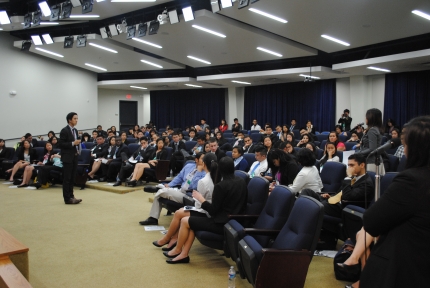
Audience members talk with Jason Tengco during the White House AAPI Youth Forum with the East Coast Asian American Student Union. May 31, 2013. (by White House Office of Public Engagement)
On Friday, May 31, the White House Initiative on Asian Americans and Pacific Islanders (AAPIs) and the White House Office of Public Engagement closed out AAPI Heritage Month 2013 by hosting a Youth Forum with the East Coast Asian American Student Union (ECAASU), featuring more than 150 young AAPI leaders from throughout the country. The goals of the Youth Forum were to educate participants about important issues facing the AAPI community, engage them around the work of the White House and the White House Initiative on AAPIs, and empower them to take action in their respective communities and campuses.
The event kicked off with keynote remarks by Secretary of Veterans Affairs Eric Shinseki, as well as panel discussions with young AAPI White House officials and student leaders. Attendees then participated in issue-based workshops aimed at highlighting the Administration’s efforts around key priorities, including passing commonsense immigration reform, implementing the Affordable Care Act, and promoting federal careers and internships. Through a series of “AAPI Mentorship Sessions,” participants also had the opportunity to dialogue with senior Administration officials, who described their careers paths in public service and shared some of the best advice and guidance that have helped them along the way.
The day also featured an action planning session where participants debriefed the Youth Forum and mapped out ways to take action within their communities and campuses, and concluded with keynote remarks by Kiran Ahuja, Executive Director of the White House Initiative on AAPIs.
Last week’s Youth Forum closed out a series of events during AAPI Heritage Month aimed at engaging youth. Throughout the month of May, the White House also hosted Mentorship Sessions on civil rights, foreign policy and national security, law, and arts and culture, as well as a series of AAPI Arts Workshops to connect established AAPI artists with middle and high school students. Such events have been part of the Administration’s larger efforts to engage youth of all ages, and we look forward to continuing to foster leadership and public service among the next generation of AAPI leaders.
Jason Tengco is the Advisor on Public Engagement for the White House Initiative on Asian Americans and Pacific Islanders.
President Obama Speaks at AAPI Heritage Month Celebration
Posted by on May 29, 2013 at 10:40 AM EDTLast night, President Obama delivered remarks before over 200 members of the Asian American and Pacific Islander (AAPI) community at a White House celebration of AAPI Heritage Month. The audience included national, state, and local community leaders; elected officials; leaders of philanthropic, youth, and arts organizations; and members of the President’s Administration, including Sri Srinivasan, who was recently confirmed unanimously by the Senate to become the first South Asian American federal appeals court judge.
In his remarks, the President highlighted the contributions of generations of Asian Americans and Pacific Islanders who, in his words, “helped build this country, and helped to defend this country, and to make America what it is today.” He said:
We value these voices because from the very beginning, ours has been a nation of immigrants; a nation challenged and shaped and pushed ever forward by diverse perspectives and fresh thinking. And in order to keep our edge and stay ahead in the global race, we need to figure out a way to fix our broken immigration system -- to welcome that infusion of newness, while still maintaining the enduring strength of our laws. And the service and the leadership of Asian Americans and Pacific Islanders have proved that point time and again.
Learn more about ImmigrationRemoving Obstacles to Care for Asian Americans and Pacific Islanders
Posted by on May 23, 2013 at 2:57 PM EDTAsian Americans and Pacific Islanders are the fastest growing ethnic group in the United States. This community comprises many diverse populations with respect to educational and socioeconomic backgrounds, linguistic characteristics, and unique cultural traditions from their countries of origin. The vibrant cultures represented have different styles and patterns of communication for giving and receiving information. Many are not able to achieve their full health potential as disparities in health care persist, specifically as it pertains to the availability of language assistance services and, historically, Asian Americans and Pacific Islanders have been less likely to have health insurance than the population as a whole.
May is “Asian American and Pacific Islander Heritage Month,” and there is no better time to talk about advancing health equity for all. The Affordable Care Act provides one of the most important levers by which we can advance that vision. The law will remove obstacles to care that many Asian Americans and Pacific Islanders historically have faced and ensure that they will have better access to stable, affordable health insurance and high quality health care suited to their needs.
Access to high quality health care. The Affordable Care Act expands access to preventive care and can help reduce health disparities for Asian American and Pacific Islanders by helping to prevent many diseases that have a disproportionate impact on this group. Recommended preventive services covered without cost-sharing under the health care law include well-child visits, blood pressure and cholesterol screenings, Pap smears and mammograms for women and flu shots for children and adults. An estimated 2.7 million AAPI with private insurance currently have access to expanded preventive services with no cost-sharing because of the health care law. Further, the nearly one million elderly and disabled Asian American and Pacific Islanders who receive coverage from Medicare also have access to an expanded list of preventive services with no cost-sharing including diabetes and colorectal cancer screening and bone mass measurement. In addition, young Asian American and Pacific Islander adults under age 26 who would have been uninsured now have coverage under their parent’s employer-sponsored or individually purchased health plan. This means that more than 97,000 Asian Americans have gained coverage.
Culturally competent health care, including communication in a language that individuals understand. Nearly 61 million people speak a language other than English at home. Language barriers impact the ability of individuals to access health care and human services. Individuals with limited ability to read, speak, write or understand English are less likely to have a regular source of primary care. Language assistance services help provide meaningful access to quality health care. The health care law expands initiatives to increase diversity in the health care professions and improve cultural competency of health care providers.
Ending insurance discrimination. In the past, insurance companies could deny coverage to children because of a pre-existing condition such as cancer, asthma, or diabetes. This discrimination is no longer allowed, and beginning in 2014, insurers are banned from discriminating against anyone with a pre-existing condition. This is important because, for example, in Hawaii, adult Asian Americans, Native Hawaiians and other Pacific Islanders have high rates of diabetes.
Secure health information. As the agency within the U.S. Department of Health and Human Services that ensures that the privacy practices of several million heath care providers, plans, and clearinghouses adhere to federal health information and privacy laws, my office, the Office for Civil Rights, works tirelessly to enforce the laws which safeguard the privacy and security of health information. Individuals have rights over their health information, including the right to get a copy of their medical record, make sure it’s correct and know who has seen it. Studies have shown that consumers pay more attention to and become more engaged in their health care when they have access to their own medical information. The Office for Civil Rights will continue its outreach efforts to inform consumers about their privacy rights.
Increased access, equity of care and patient confidence are major drivers in reducing disparities in all communities, including the Asian American and Pacific Islander community.
Additional Resources:
Visit us to learn more about the Office for Civil Rights and our work to help protect individuals from discrimination and ensure the privacy of health information.
The Health Care Law and You is a presentation tool developed by the U.S. Department of Health and Human Services to educate community members about the benefits of the Affordable Care Act. This resource has been translated into the following languages: Spanish, Chinese, Korean, Vietnamese, Tagalog, Hindi, Bengali, Hmong, Khmer, Laotian, Samoan and Tongan.
The Enhanced National Standards for Culturally and Linguistically Appropriate Services in Health and Health Care (the Enhanced National CLAS Standards) are intended to advance health equity, improve quality, and help eliminate health care disparities by providing a blueprint for individuals and health and health care organizations to implement culturally and linguistically appropriate services.
The U.S. Department of Health and Human Services (HHS) published its 2013 Language Access Plan ensuring access to the Department’s programs and activities to people with limited English proficiency (LEP).
Juliet K. Choi is Chief of Staff and Senior Advisor at the U.S. Department of Health and Human Services Office for Civil Rights.
Learn more about Health CareDoing Business in Asia
Posted by on May 22, 2013 at 6:08 PM EDTHere at the Export-Import Bank of the United States, we are committed to supporting American jobs through exports and helping American businesses reach the 95 percent of the world’s customers who live overseas.
Some 40 percent of our financing goes to one of the world’s most dynamic export markets – Asia. In fact, it’s the largest single market for our Bank’s financing. At the Bank, we’re keenly aware of Asia’s growth potential and its crucial importance for supporting American jobs – and committed to providing the necessary financing.
That is just one of the many reasons why I took part in the “Doing Business in Asia” forum at the White House earlier this week, attended by more than 80 U.S. executives currently doing business or interested exporting to that region. These executives heard Administration officials discuss President Obama’s rebalance to the Asia-Pacific region and how U.S. economic leadership in the region is a critical component of the rebalance. Representatives from the Department of Commerce, the Department of State and the U.S. Trade Representative’s Office spoke about the record level of $2.2 trillion in annual exports achieved under the President’s National Export Initiative.
They described how agencies are working together to help U.S. exporters expand to international markets through market information, advocacy, and programs that connect US companies with in-country resources.
Representing the Bank, I described financing programs that decrease risk of exporting and facilitate financing to “level the playing field” so the price of the U.S. export and financing packages are cost competitive – complementing programs by the Overseas Private Investment Corporation, and the U.S. Trade and Development agency
We showcased financing programs tailored for small exporters typically shut out by commercial lenders. These programs offer fixed-term interest rates that are otherwise accessible only to the world’s largest corporations.
There was a lot of excitement about negotiations underway for the Trans-Pacific Partnership free trade agreement with Asia-Pacific Economic Cooperation (APEC) nations. This high-standard agreement will open new markets and allow goods and services to flow more seamlessly across borders.
Another innovative program discussed was USAID’s Development Innovation Ventures which supports breakthrough solutions to the world’s most difficult development challenges.
It was an exciting day and the beginning, I believe, of new progress in U.S. exports that will put even more Americans back to work. Clearly, our nation’s future is in exports. And Asia is one of the most promising regions for those exports, and we’re proud to help support American businesses reaching those markets.
Learn more about the President's FY 2014 Federal Budget and the Asia-Pacific here.
Pat Loui is a Member of the Board of Directors at the Export-Import Bank of the United States.
Learn more about , , ,Our Land of Limitless Opportunities
Posted by on May 20, 2013 at 12:10 PM EDTNearly everyone in America has an immigration story to share. Our voices are louder when we speak together, so please share your stories and highlight the work that’s being done in your communities. Together we can achieve commonsense immigration reform.
Dr. Tung Thanh Nguyen is a member of the President’s Advisory Commission on Asian Americans and Pacific Islanders. Dr. Nguyen is also a Professor of Medicine at the University of California, San Francisco.
Learn more about Immigration
- &lsaquo previous
- …
- 28
- 29
- 30
- 31
- 32
- 33
- 34
- 35
- 36
- …
- next &rsaquo
White House Blogs
- The White House Blog
- Middle Class Task Force
- Council of Economic Advisers
- Council on Environmental Quality
- Council on Women and Girls
- Office of Intergovernmental Affairs
- Office of Management and Budget
- Office of Public Engagement
- Office of Science & Tech Policy
- Office of Urban Affairs
- Open Government
- Faith and Neighborhood Partnerships
- Social Innovation and Civic Participation
- US Trade Representative
- Office National Drug Control Policy
categories
- AIDS Policy
- Alaska
- Blueprint for an America Built to Last
- Budget
- Civil Rights
- Defense
- Disabilities
- Economy
- Education
- Energy and Environment
- Equal Pay
- Ethics
- Faith Based
- Fiscal Responsibility
- Foreign Policy
- Grab Bag
- Health Care
- Homeland Security
- Immigration
- Innovation Fellows
- Inside the White House
- Middle Class Security
- Open Government
- Poverty
- Rural
- Seniors and Social Security
- Service
- Social Innovation
- State of the Union
- Taxes
- Technology
- Urban Policy
- Veterans
- Violence Prevention
- White House Internships
- Women
- Working Families
- Additional Issues
